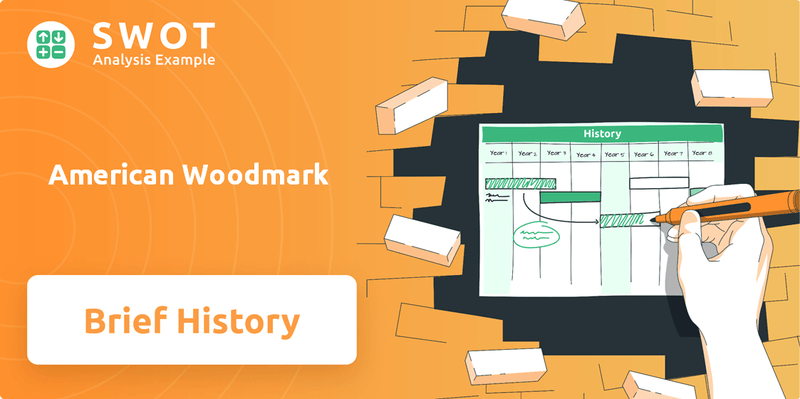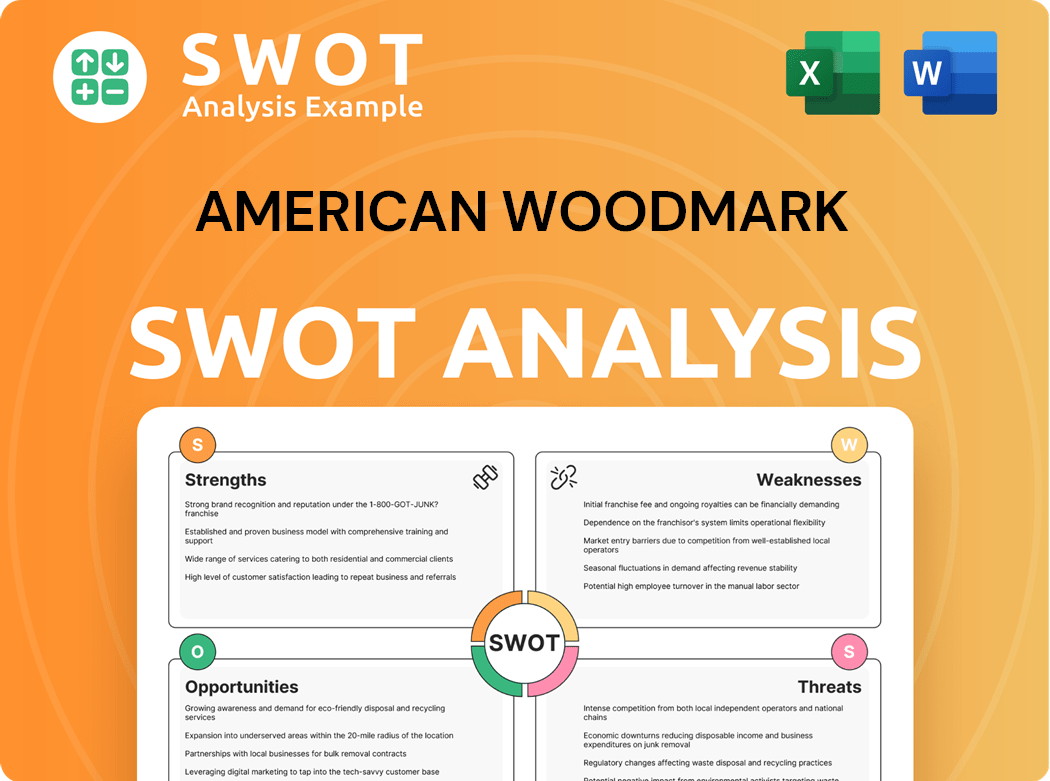American Woodmark Bundle
How did a dentist's vision evolve into a cabinetry giant?
Discover the fascinating American Woodmark SWOT Analysis and trace the remarkable journey of American Woodmark Company, a leading cabinet manufacturer, from its unexpected origins. Uncover the pivotal moment in 1951 when a dentist's innovative idea sparked the creation of Formed Laminates Inc., setting the stage for an industry titan. Explore how this initial venture transformed into a major player in the kitchen and bath market.

From its humble beginnings as a dental cabinet maker, American Woodmark's story is a testament to strategic growth and adaptability. This brief history of American Woodmark reveals how the company navigated the evolving landscape of the wood products industry, expanding its operations and product range. Learn about the company's significant milestones, its current market position, and its impact on the housing market. This American Woodmark company overview will provide a detailed look at its evolution.
What is the American Woodmark Founding Story?
The story of the American Woodmark Company began with a dentist's vision. Dr. Alvin Goldhush, a Long Island dentist, saw a need for better dental cabinets, leading him to start Formed Laminates Inc. This marked the initial foray into what would become a major player in the wood products industry.
The company's evolution continued with a name change to Raygold Corp. in 1957 and a move to West Virginia. Later, in 1971, Boise Cascade Corp. acquired Raygold Corp. for approximately $6 million. The roots of the modern American Woodmark Corporation, however, were planted in 1980.
In 1980, a leveraged buyout by four executives from Boise Cascade's cabinet division—Bill Brandt, Al Graber, Jeff Holcomb, and Don Mathias—led to the formation of American Woodmark Corporation. This strategic move involved over 1,100 team members and three manufacturing facilities, focusing on kitchen, bath, and home organization products. William F. Brandt, Jr., held approximately 30% ownership. This transition occurred as Boise Cascade shifted its focus from wood products to paper products.
American Woodmark's history is marked by strategic shifts and expansions.
- Founded in 1951 as Formed Laminates Inc. by Dr. Alvin Goldhush.
- Renamed Raygold Corp. in 1957.
- Acquired by Boise Cascade in 1971 for around $6 million.
- American Woodmark Corporation formed in 1980 via a leveraged buyout.
- Initial focus on kitchen, bath, and home organization products.
American Woodmark SWOT Analysis
- Complete SWOT Breakdown
- Fully Customizable
- Editable in Excel & Word
- Professional Formatting
- Investor-Ready Format

What Drove the Early Growth of American Woodmark?
The early years of the American Woodmark Company were marked by strategic partnerships and rapid expansion. Established in 1980, the company quickly focused on building relationships with major retailers. This early focus set the stage for significant growth in the kitchen cabinets market. The company's history is a testament to its ability to adapt and capitalize on market opportunities.
By 1986, the American Woodmark went public and moved its headquarters to Winchester, Virginia. During this period, it established crucial relationships with big-box retailers. These partnerships, particularly with The Home Depot and Lowe's, were pivotal for distribution.
By fiscal year 1987, the American Woodmark Company offered 18 cabinet lines. Sales exceeded $100 million for the first time, reaching $116 million. This early success demonstrated the company's ability to scale its operations effectively within the wood products industry.
A significant restructuring in 1989 involved expanding cabinet lines and assembly plants. New brands were introduced to address channel conflict. The Timberlake brand was launched in April 1990 for the new construction market, while the American Woodmark brand continued at Home Depot, and Shenandoah was added for Lowe's.
By 1999, the home remodeling sector accounted for approximately 70% of the business. The company strategically focused on gaining a larger share from home improvement superstores. James J. 'Jake' Gosa was named president and CEO. By fiscal year 1993, revenues grew to $167.3 million, and by fiscal year 1995, sales reached $197.4 million.
American Woodmark PESTLE Analysis
- Covers All 6 PESTLE Categories
- No Research Needed – Save Hours of Work
- Built by Experts, Trusted by Consultants
- Instant Download, Ready to Use
- 100% Editable, Fully Customizable

What are the key Milestones in American Woodmark history?
The American Woodmark Company has a history marked by significant milestones, including product innovations and strategic responses to market dynamics. The company, a prominent cabinet manufacturer, has navigated both successes and challenges in the wood products industry, shaping its position in the market.
| Year | Milestone |
|---|---|
| 2019 | The Sedgewood Bath Vanities were recognized as one of The Home Depot's Innovation Winners. |
| 2020 | Honored by Women on Boards for having at least 20% female representation on its board of directors. |
| 2025 | Net sales decreased by 11.7% year-over-year in Q4, and 7.5% for the full fiscal year. |
American Woodmark has consistently pursued innovation, particularly in its product offerings. A key example is the Sedgewood Bath Vanities, recognized for their user-friendly design.
The Sedgewood Bath Vanities were recognized as one of The Home Depot's 2019 Innovation Winners. These vanities feature an easy left or right side swapping feature, simplifying plumbing accommodation and maximizing layout.
American Woodmark emphasizes 'disruptive innovation' as a core tenet of its vision. This focus drives the company to constantly seek new and improved product designs and manufacturing processes.
Despite its achievements, American Woodmark has faced challenges, especially in a dynamic market. Economic uncertainties and shifts in consumer confidence have impacted the company's performance.
The company has faced market downturns and competitive threats in the new construction and remodel markets. These challenges are influenced by economic uncertainties and declining consumer confidence.
In Q4 2025, net sales decreased by 11.7% year-over-year to $400.4 million, and for the full fiscal year 2025, net sales decreased by 7.5% to $1.71 billion. The gross profit margin also decreased by 160 basis points to 17% of net sales in Q4 2025.
American Woodmark has undertaken strategic pivots and repositioning efforts to address these challenges. This involves focusing on operational efficiencies and cost control to navigate the tough market environment.
The company actively manages its capital through share repurchase programs. During fiscal year 2025, American Woodmark bought back 1.17 million shares for $96.7 million.
American Woodmark Business Model Canvas
- Complete 9-Block Business Model Canvas
- Effortlessly Communicate Your Business Strategy
- Investor-Ready BMC Format
- 100% Editable and Customizable
- Clear and Structured Layout

What is the Timeline of Key Events for American Woodmark?
The Woodmark history began in 1951 when Dr. Alvin Goldhush founded Formed Laminates Inc. in Long Island, which marked the start of what would become the American Woodmark Company. Over the years, the company evolved through name changes, acquisitions, and strategic expansions. A pivotal moment was the 1980 leveraged buyout by four executives, leading to the formation of American Woodmark Corporation. The company then went public in 1986, continuing to grow through product line expansions, brand introductions like Timberlake in 1990 and Waypoint in 2010, and acquisitions such as Knapp Woodworking in 1999. The company has also received recognition for its innovations and commitment to female representation.
| Year | Key Event |
|---|---|
| 1951 | Dr. Alvin Goldhush founded Formed Laminates Inc. in Long Island, initially producing dental cabinets. |
| 1957 | The company changed its name to Raygold and expanded, moving to West Virginia. |
| 1971 | Raygold Corp. was acquired by Boise Cascade Corp. |
| 1980 | Four Boise Cascade executives executed a leveraged buyout, forming American Woodmark Corporation. |
| 1986 | American Woodmark went public on Nasdaq and moved its headquarters to Winchester, Virginia. |
| 1990 | The Timberlake brand was introduced for the new construction market. |
| 1996 | American Woodmark paid its first quarterly cash dividend. |
| 1999 | The company acquired Knapp Woodworking. |
| 2010 | The Waypoint brand was introduced to support independent showrooms. |
| 2019 | The company was recognized for its Sedgewood Bath Vanities as a Home Depot Innovation Winner. |
| 2020 | American Woodmark was honored by Women on Boards for female representation. |
| FY 2024 | Net sales were $1.848 billion, and adjusted EBITDA reached $253 million. |
| FY 2025 | Net sales decreased to $1.71 billion, and adjusted EBITDA was $208.6 million. |
| May 2025 | Company announces Q4 2025 earnings, with adjusted EPS of $1.61, surpassing forecasts. |
In fiscal year 2024, American Woodmark reported net sales of $1.848 billion and an adjusted EBITDA of $253 million. However, fiscal year 2025 saw a decrease in net sales to $1.71 billion, with an adjusted EBITDA of $208.6 million. The company’s Q4 2025 earnings, announced in May 2025, showed an adjusted EPS of $1.61, exceeding expectations, despite the overall decrease in sales.
American Woodmark anticipates a challenging demand environment for fiscal year 2026, projecting net sales to range from low single-digit declines to low single-digit increases. The adjusted EBITDA for fiscal year 2026 is expected to be between $175 million and $200 million. The company anticipates sales recovery in the second half of fiscal year 2026.
The company is focusing on operational efficiency, cost control, and digital transformation. American Woodmark plans to continue investing in automation, capacity, and digital transformation to achieve its long-term targets. These initiatives align with the company's vision of providing high-quality cabinetry and adapting to market needs.
Analyst predictions suggest a potential upside for American Woodmark's stock, with an average one-year price target of $96.50 by April 28, 2026, indicating a potential 68.77% upside from its current price. This positive outlook is supported by the company’s strategic focus on growth and operational improvements. Leadership is focused on removing economic uncertainties.
American Woodmark Porter's Five Forces Analysis
- Covers All 5 Competitive Forces in Detail
- Structured for Consultants, Students, and Founders
- 100% Editable in Microsoft Word & Excel
- Instant Digital Download – Use Immediately
- Compatible with Mac & PC – Fully Unlocked

Related Blogs
- What is Competitive Landscape of American Woodmark Company?
- What is Growth Strategy and Future Prospects of American Woodmark Company?
- How Does American Woodmark Company Work?
- What is Sales and Marketing Strategy of American Woodmark Company?
- What is Brief History of American Woodmark Company?
- Who Owns American Woodmark Company?
- What is Customer Demographics and Target Market of American Woodmark Company?
Disclaimer
All information, articles, and product details provided on this website are for general informational and educational purposes only. We do not claim any ownership over, nor do we intend to infringe upon, any trademarks, copyrights, logos, brand names, or other intellectual property mentioned or depicted on this site. Such intellectual property remains the property of its respective owners, and any references here are made solely for identification or informational purposes, without implying any affiliation, endorsement, or partnership.
We make no representations or warranties, express or implied, regarding the accuracy, completeness, or suitability of any content or products presented. Nothing on this website should be construed as legal, tax, investment, financial, medical, or other professional advice. In addition, no part of this site—including articles or product references—constitutes a solicitation, recommendation, endorsement, advertisement, or offer to buy or sell any securities, franchises, or other financial instruments, particularly in jurisdictions where such activity would be unlawful.
All content is of a general nature and may not address the specific circumstances of any individual or entity. It is not a substitute for professional advice or services. Any actions you take based on the information provided here are strictly at your own risk. You accept full responsibility for any decisions or outcomes arising from your use of this website and agree to release us from any liability in connection with your use of, or reliance upon, the content or products found herein.